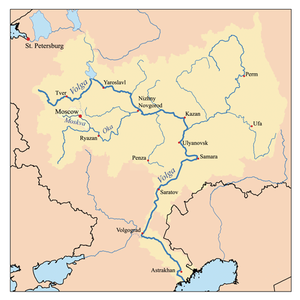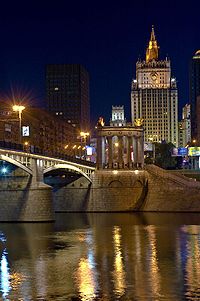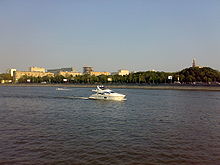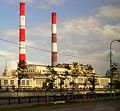- Moskva River
-
Coordinates: 55°05′N 38°50′E / 55.083°N 38.833°E
 Map of the Volga watershed with the Moskva highlighted; the two rivers are directly connected by the Moscow Canal.
Map of the Volga watershed with the Moskva highlighted; the two rivers are directly connected by the Moscow Canal.
The Moskva River (Russian: Москва-река, Moskva-reka) is a river that flows through the Moscow and Smolensk Oblasts in Russia, and is a tributary of the Oka River.
Contents
Etymology
Moskva and Moscow are two different renderings of the same Russian word Москва. The city is named after the river. The origin of the name is unknown, although several theories exist.[1] One theory suggests that the source of the name is an ancient Finnic language, in which it means "marshy place, dark waters, gnat".[2] Alternatively, the name may come from the Mordvinian language, meaning "bear-river".[citation needed]. Similar meaning is in Mari language where moská denotes "bear"[3] whereas Mari word ava implies "mother"[4].
Hydrology
The length of the river is 503 km. The area of its drainage basin is 17,600 km². Vertical level drop is 155 metres (long-term average). Maximum depth above Moscow city limits - 3 metres, and up to 6 metres below it .[5] Normally, it freezes in November–December and begins to thaw around late March. In downtown Moscow, the river freezes occasionally; in an unusually warm winter of 2006-2007, ice began setting on January, 25. Absolute water level in downtown Moscow is 120.0 metres above sea level (long-term average of summer lows after World War II), historical maximum was set by the 1908 flood - 127.25 metres above sea level.[6]
Sources of water
Main tributaries are the Ruza, Istra, Yauza, Pakhra, and Severka rivers. Sources of water are estimated as 61% thaw, 12% rain and 27% subterranean. After completion of Moscow Canal (1932–1937), Moskva River also collects a share of Upper Volga water. This enabled reliable commercial shipping, which was previously interrupted by summer droughts (older dams built in 1785, 1836 and 1878 were not effective). Average discharge, including Volga waters, varies from 38 m³/s near Zvenigorod to 250 m³/s at Oka inlet. Flow speed, depending on the season, varies from 0.1 m/s (winter, dams closed) to 1.5-2.0 m/s (may, dams open).
Cities
Moscow (Москва́), the capital of Russia, is situated on its banks. The river also flows through the towns of Mozhaysk, Zvenigorod, Zhukovsky, Bronnitsy, Voskresensk, and — at the confluence of the Moskva and Oka — Kolomna. In 2007, there are 49 bridges across Moskva River and its canals within Moscow city limits; the first stone bridge was erected in 1692. Within the city, river is 120–200 metres wide, the narrowest point exactly under the Kremlin walls. Drinking water for the city of Moscow is collected from five stations on Moskva River and Upper Volga reservoirs (north and north-west from the city).
Islands
Canals, built within Moscow city limits, form a number of islands. Some of them have names in Russian, some have none. Major, permanent islands (east to west) are:
- Serebryany Bor. Separated from the mainland in 1930s
- Tatarskaya Poima, commonly known as Mnevniki. Separated from the mainland in 1930s
- Balchug Island, also known as Bolotny Ostrov, lying just opposite the Kremlin. The island was formed by construction of Vodootvodny Canal in 1780s, and has no official name in Russian. Moscow residents informally call it "Bolotny Ostrov" (Bog Island) while members of Moscow's English-speaking community refer to it as Balchug.
- One uninhabited island north from Nagatino
- Three uninhabited islands east from Nagatino, connected by Pererva dam and lock system
- Various uses of the embankments within the city of Moscow
-
The Kremlin seen from the Moscova
-
Cathedral and Gorky Park
-
Moscow River towards the Kremlin
Trivia
- The Battle of Borodino is known in French as "Battle of the Moskva River" (Bataille de la Moscowa).
- The Moskva River, as well as Gorky Park are mentioned in Scorpions' ballad Wind of Change. The first lines of the lyrics read as : "I follow the Moskva/ Down to Gorky Park/ Listening to the wind of change"
- Since winter 2009-2010 on the Moskva River new entertainment is entered: walk on the winter river on the ice breaker. There are five walking river ice breakers which ply on a route from a mooring Hotel Ukraine to the Novospassky Monastery and back. Duration of walk will make about 2 hours.[7]
References
- ^ Russian: On the origins of Moskva
- ^ The meaning of the name Moscow
- ^ Entry "maska" in Mari-Russian dictionary
- ^ Entry "ava" in Mari-Russian dictionary
- ^ All numerical data: Russian: Энциклопедия "Москва", M, 1997 (Encyclopedia of Moscow, Moscow, 1997)
- ^ Russian: Носарев В.А., Скрябина, Т.А., "Мосты Москвы", М, "Вече", 2004, стр.194 (Bridges of Moscow, 2004, p.194) ISBN 5-9533-0183-9
- ^ "Москвичи смогут поплавать на ледоколах" (in Russian). Water transport. Moscow, Russia: Gudok.ru. 2009-11-13. http://www.gudok.ru/transport/vodniy/news.php?ID=332409. Retrieved 21 November 2009.
Categories:- Rivers of Moscow Oblast
- Rivers of Smolensk Oblast
- Geography of Moscow
- Volga basin
Wikimedia Foundation. 2010.







